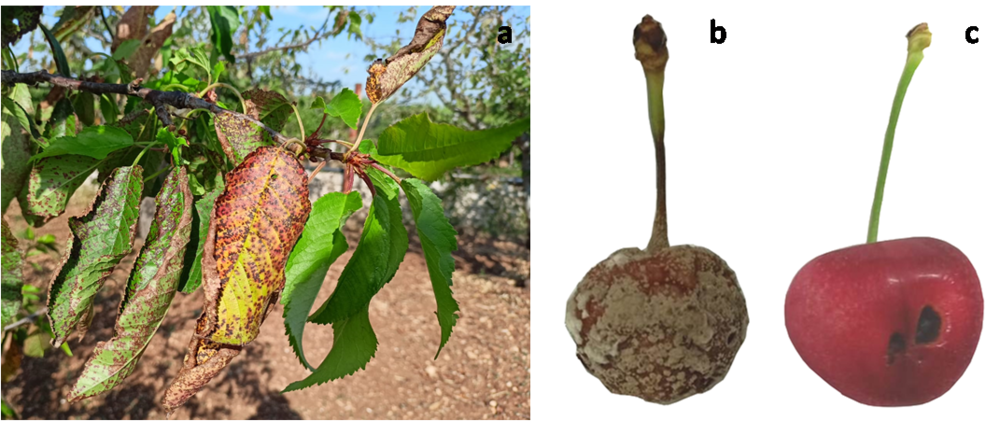
Donato Gerin - Università di Bari (IT)
Cherry Times technical-scientific committee
The cherry trees are stone fruit whose fruits are known for their many health benefits. The nutritive value of the fruits is directly related to their quality, which can be compromised by numerous adversities both in the field and post-harvest. Various fungi and bacteria can cause disease on cherry trees.
Fungal diseases of particular importance include cylindersporiosis, corynaeum, brown rot, and root rots from Armillaria mellea and Rosellinia nectrix, while bacterial diseases include bacterial canker and bacterial root and collar canker.
Cylindrosporiosis, caused by Blumeriella jaapii (an. Cylindrosporium padi), is one of the most damaging diseases for cherry trees because of the damage caused on the leaves, and if not effectively controlled, it leads to premature phylloptosis causing the plant's photosynthetic capacity to be reduced (Figure 1a).
Coryneal, caused by Stigmina carpophila (syn. Coryneum beijerinckii), is another disease that typically affects leaves, where reddish-brownish indentations are observed sometimes surrounded by a yellowish halo a few millimeters in diameter that over time necrotize and fall off originating the classic symptom of balling.
Another important fungal disease of cherry is brown rot. Caused by several species of the genus Monilinia, and in particular Monilinia laxa and Monilinia fructicola, the disease owes its name to the brownish efflorescence that develops on the surface of infected fruit as a result of the evasion of these mycetes accompanied by the production of asexual spores (Figure 1b).
In addition to fruit, these pathogens can attack the cherry tree as early as flowering compromising much of the production and young branches on which the formation of cankers often accompanied by the presence of gummy exudates is observed. Armillaria mellea and Dematophora (an. Rosellinia) necatrix are the main agents of root rot on cherry trees.
At the level of the collar and roots, whitish mycelium can often be observed, and internally, the wood shows obvious necrotic areas and a breakdown of the cortical zone. Symptoms observed on the crown of infected plants are nonspecific, poor vegetative growth, chlorosis and necrosis of leaves followed by phylloptosis.
Similar symptoms are caused by Agrobarterium tumefaciens, an agent of bacterial tumor of the collar and roots, which is characterized by the presence of tumor outgrowths on said organs that allow identification of the pathogen. Two bacterial species belonging to the Pseudomonas syringae species complex, such as P. syringae pv. morsprunorum and P. syringae pv. syringae are the main causative agents of bacterial cancer on cherry trees.
In addition to the presence of cankers on young branches and buds, these species can cause symptoms on leaves and fruits that consist of slightly sunken necrotic indentations surrounded by a chlorotic halo (Figure 1c).

On a profitable crop such as cherry, whose harvest is concentrated in a fairly short period of time, protection from these diseases requires adequate knowledge of the biology of the causal agents as well as the available means of protection that must be applied considering the sustainability of cherry production. Removal and burning of infected material (e.g., mummified fruit, branches with cankers) are useful practices to limit potential sources of inoculum for infections in the following year mainly from brown rot and bacterial canker.
Appropriate management of vegetative vigor with green pruning, which promotes the entry of light and air circulation helps to contain coryneous and cylindersporiosis. The use of healthy propagation material is essential to avoid problems from root rot and bacterial blight from the early years after planting, which once present in the cherry orchard can only be slowed down by timely removal of infected plants. However, for root rot, cylindersporiosis, brown rot and bacterial cancer, it is possible to choose less susceptible rootstocks or varieties.
Protection by chemical means, to be implemented in full synergy with available agronomic practices, involves applications with cupric compounds (considering the maximum limits provided by the reference regulations) and synthetic fungicides (e.g., dodine and captan) at the leaf fall stage and at vegetative resumption toward coryneus, cylindersporiosis and bacterial canker.
Also important is the protection of first the inflorescences and then the fruits from brown rot through the use of available fungicides (captan, fludioxonil+cyprodinil, boscalid+pyraclostrobin, and triazoles), which can be minimized by the use of microbial antagonists such as Bacillus amyloliquefaciens sbsp. plantarum D747, B. subtilis QST 713, and Metschnikowia fructicola NRRL Y-27328.
Donato Gerin, Rita Milvia De Miccolis Angelini, Stefania Pollastro, Francesco Faretra
University of Bari (IT)
Cherry Times - All rights reserved














